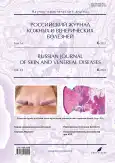Красный плоский лишай и сопряжённые с зудом психосоматические расстройства
- Авторы: Дороженок И.Ю.1,2, Снарская Е.С.1, Михайлова М.1
-
Учреждения:
- Первый Московский государственный медицинский университет имени И.М. Сеченова (Сеченовский Университет)
- Научный центр психического здоровья
- Выпуск: Том 24, № 6 (2021)
- Страницы: 543-551
- Раздел: ДЕРМАТОЛОГИЯ
- URL: https://journals.rcsi.science/1560-9588/article/view/100612
- DOI: https://doi.org/10.17816/dv100612
- ID: 100612
Цитировать
Аннотация
Обоснование. Актуальность изучения ассоциированных с зудом психосоматических расстройств у пациентов с разными клиническими фенотипами красного плоского лишая обусловлена широким спектром транснозологической коморбидности нозогенных и депрессивных расстройств.
Цель ― клиническая верификация и типологическая дифференциация сопряжённых с зудом психосоматических расстройств в соответствии с выделенными нами фенотипами красного плоского лишая у пациентов изученной выборки.
Материал и методы. Обследовано 120 пациентов (77 женщин и 43 мужчины, средний возраст 47,6±5,2 лет) с различными фенотипами красного плоского лишая и сопряжёнными с зудом коморбидными психосоматическими расстройствами. Клинико-дерматологический фенотип заболевания оценивался с помощью современного индекса оценки распространённости и тяжести красного плоского лишая в клинической практике (Lichen planus area and severity index, LPASI); опросника выраженности зуда (Behavioral rating scores, BRS), опросника дерматологического индекса качества жизни (ДИКЖ); психопатологический фенотип ― с использованием госпитальной шкалы тревоги и депрессии (Hospital anxiety and depression scale, HADS); клинико-психологический ― с использованием личностных самоопросников и проективных методик.
Результаты. Выделены и типологически дифференцированы сопряжённые с зудом психосоматические расстройства у пациентов с красным плоским лишаём: нозогенные реакции, развивающиеся в ответ на проявления кожного заболевания (депрессивные, социофобические, ипохондрия красоты), а также рекуррентные депрессии. При каждом типе психосоматических расстройств выявлены различные соотношения дерматологических и психосоматических симптомов. Нозогенные реакции, развивающиеся в рамках рассмотренных соотношений, сопоставимы с нозогениями при тяжёлых соматических заболеваниях и клинически проявляются тревожно-депрессивными расстройствами. В других случаях роль ключевого триггера приобретает не тяжесть дерматоза, как при нозогенных депрессиях, а косметически значимая локализация высыпаний. Указанные психосоматические расстройства представлены социофобическими нозогенными реакциями, а также нозогениями по типу ипохондрии красоты, в формирование которых существенный вклад вносят конституционально обусловленные соматоперцептивные акцентуации с деформацией образа тела. Определена роль конституциональных факторов и соматоперцептивных акцентуаций. Проанализирована структура амплифицированного кожного зуда, включая стрессогенное влияние пандемии, вызванной вирусом SARS-CoV. Представлены методики эффективной терапии на основе комплексного междисциплинарного подхода.
Заключение. Эффективные диагностика и лечение сопряжённых с зудом психосоматических расстройств способствуют существенной оптимизации течения красного плоского лишая и повышению качества жизни пациентов.
Полный текст
Открыть статью на сайте журналаОб авторах
Игорь Юрьевич Дороженок
Первый Московский государственный медицинский университет имени И.М. Сеченова (Сеченовский Университет); Научный центр психического здоровья
Автор, ответственный за переписку.
Email: idoro@bk.ru
ORCID iD: 0000-0003-1613-2510
Scopus Author ID: ID: 35773056200;
к.м.н., доцент
Россия, 119992, Москва, ул. Трубецкая, д. 8, стр. 2; МоскваЕлена Сергеевна Снарская
Первый Московский государственный медицинский университет имени И.М. Сеченова (Сеченовский Университет)
Email: snarskaya-dok@mail.ru
ORCID iD: 0000-0002-7968-7663
SPIN-код: 3785-7859
Scopus Author ID: 8714450500
ResearcherId: AAT-5833-2020
д.м.н., профессор
Россия, МоскваМариана Михайлова
Первый Московский государственный медицинский университет имени И.М. Сеченова (Сеченовский Университет)
Email: Dermatolog003@mail.ru
ORCID iD: 0000-0002-7895-6630
аспирант
Россия, МоскваСписок литературы
- Jalenques I., Lauron S., Almon S., et al. Prevalence and odds of signs of depression and anxiety in patients with lichen planus: systematic review and meta-analyses // Acta Derm Venereol. 2020. Vol. 100, N 18. Р. adv 00330. doi: 10.2340/00015555-3660
- Sawant N.S., Vanjari N.A., Khopkar U., Adulkar S. A study of depression and quality of life in patients of lichen planus // Sci World J. 2015. Vol. 2015. Р. 817481. doi: 10.1155/2015/817481
- Смулевич А.Б., Иванов О.Л., Львов А.Н., Дороженок И.Ю. Психодерматологические расстройства. Дерматовенерология. Национальное руководство. Краткое издание. Москва: ГЭОТАР-Медиа, 2013. С. 406–413.
- Cassol-Spanemberg J., Blanco-Carrión A., de Rivera-Campillo M.E., et al. Cutaneous, genital and oral lichen planus: a descriptive study of 274 patients // J Med Oral Patol Oral Cir Bucal. 2019. Vol. 24, N 1. Р. e1–e7. doi: 10.4317/medoral.22656
- Welz-Kubiak K., Reich A., Szepietowski J. Clinical Aspects of itch in lichen planus // Acta Derm Venereol. 2017. Vol. 97, N 4. Р. 505–508. doi: 10.2340/00015555-2563
- Gupta A., Mohan R.P., Gupta S., Malik S. Roles of serum uric acid, prolactin levels, and psychosocial factors in oral lichen planus // J Oral Sci. 2017. Vol. 59, N 1. Р. 139–146. doi: 10.2334/josnusd.16-0219
- Zeidler C., Pereira M.P., Huet F., et al. Pruritus in autoimmune and inflammatory dermatoses // Front Immunol. 2019. Vol. 10. Р. 1303. doi: 10.3389/fimmu.2019.01303
- Krajewski P.K., Maj J., Szepietowski J.C. Cutaneous Hyperaesthesia in SARS-CoV-2 infection: rare but not unique clinical manifestation // Acta Derm Venereol. 2021. Vol. 101, N 1. Р. adv00366. doi: 10.2340/00015555-3729
- Snarskaya E.S., Dorozhenok I.Yu., Mikhailova M.V. Clinical phenotypes of lichen planus and transnosological psychosomatic comorbid states // Medical Alphabet. 2021. Vol. 27, Р. 26–30. doi: 10.33667/2078-5631-2021-27-26-30
- Dorozhenok I.Y., Snarskaya E.S., Mikhailova M.V. [Lichen planus, COVID-19 and depression: psychosomatic correlations] // Zh Nevrol Psikhiatr im. S.S. Korsakova. 2022. Vol. 122, N 1. Р. 122–125. doi: 10.17116/jnevro2022122011122
- Burgos-Blasco P., Fernandez-Nieto D., Selda-Enriquez G., et al. COVID-19: a possible trigger for oral lichen planus? // Int J Dermatol. 2021. Vol. 60. Р. 882–883. doi: 10.1111/ijd.15529
- Diaz-Guimaraens B., Dominguez-Santas M., Suarez-Valle A., et al. Annular lichen planus associated with coronavirus SARS-CoV-2 disease (COVID-19) // Int J Dermatol. 2021. Vol. 60. Р. 246–247. doi: 10.1111/ijd.15338
- Психосоматические расстройства. Руководство для практических врачей / под ред. академика РАН А.Б. Смулевича. Москва: МЕДпресс-информ, 2019. С. 22–23.
- Iob Е., Frank Р., Steptoe A., Fancourt D. Levels of severity of depressive symptoms among at-risk groups in the uk during the COVID-19 pandemic // JAMA Netw Open. 2020. Vol. 3, N 10. Р. e2026064. doi: 10.1001/jamanetworkopen.2020.26064
- Van Rheenen T.E., Meyer D., Neill E., et al. Mental health status of individuals with a mood-disorder during the COVID-19 pandemic in Australia: Initial results from the COLLATE project // J Affect Disord. 2020. Vol. 275. Р. 69–77. doi: 10.1016/j.jad.2020.06.037
- Патрушев А.В., Самцов А.В., Сухарев А.В., и др. Новый индекс для оценки тяжести течения плоского лишая в клинической практике // Вестник дерматологии и венерологии. 2020. Т. 96, № 3. С. 27–33. doi: 10.25208/vdv1145
Дополнительные файлы








